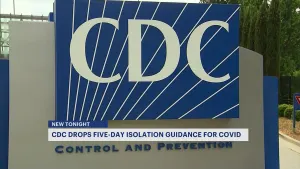COVID has killed about as many Americans as the 1918-19 flu
COVID-19 has now killed about as many Americans as the 1918-19 Spanish flu pandemic did — approximately 675,000.
Share:
More Stories
0:22

Cold Spring Village Hall closed due to COVID-19 surge and staff shortages
416ds ago
Hometown Heroes in the Hudson Valley
463ds ago1:28

Medical experts recommend to still take precautions following CDC's revised COVID isolation guidelines
607ds ago1:52

Judge: 3 men convicted in COVID-19 relief aid fraud
628ds ago1:47

Wondrous Things store in Briarcliff Manor to close after 34 years; everything 25% off
755ds ago0:28

Rockland small businesses get COVID-19 reimbursement grant
756ds ago0:22

Cold Spring Village Hall closed due to COVID-19 surge and staff shortages
416ds ago
Hometown Heroes in the Hudson Valley
463ds ago1:28

Medical experts recommend to still take precautions following CDC's revised COVID isolation guidelines
607ds ago1:52

Judge: 3 men convicted in COVID-19 relief aid fraud
628ds ago1:47

Wondrous Things store in Briarcliff Manor to close after 34 years; everything 25% off
755ds ago0:28

Rockland small businesses get COVID-19 reimbursement grant
756ds agoCOVID-19 has now
killed about as many Americans as the 1918-19 Spanish flu pandemic did —
approximately 675,000. And like the worldwide scourge of a century ago,
the coronavirus may never entirely disappear from our midst.
Instead,
scientists hope the virus that causes COVID-19 becomes a mild seasonal
bug as human immunity strengthens through vaccination and repeated
infection. That would take time.
“We
hope it will be like getting a cold, but there’s no guarantee,” said
Emory University biologist Rustom Antia, who suggests an optimistic
scenario in which this could happen over a few years.
MORE: Stop the Spread
For now, the pandemic still has the United States and other parts of the world firmly in its jaws.
The
delta-fueled surge in new infections may have peaked, but U.S. deaths
still are running at over 1,900 a day on average, the highest level
since early March, and the country’s overall toll stood at close to
674,000 as of Monday morning, according to data collected by Johns
Hopkins University, though the real number is believed to be higher.
Winter
may bring a new surge, though it will be less deadly than last year’s,
according to one influential model. The University of Washington model
projects an additional 100,000 or so Americans will die of COVID-19 by
Jan. 1 , which would bring the overall U.S. toll to 776,000.
The
1918-19 influenza pandemic killed an estimated 675,000 Americans in a
U.S. population one-third the size of what it is today. It struck down
50 million victims globally at a time when the world had one-quarter as
many people as it does now. Global deaths from COVID-19 now stand at
more than 4.6 million.
By CARLA K. JOHNSON
More from News 12
1:38

Local elected officials take action against habitual flooding

Bronx River Parkway closed from Yonkers to White Plains
2:14

Nonprofit concerned that possible SNAP cuts could impact people's mental health
2:10

Rockland Executive candidates campaign on overdevelopment, fiscal responsibility and CHPE pipeline project
2:02

‘Almost no one knew.’ State investigating special South Blooming Grove election
0:51
